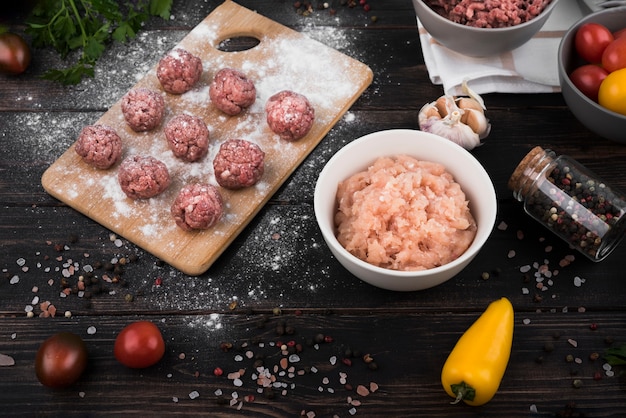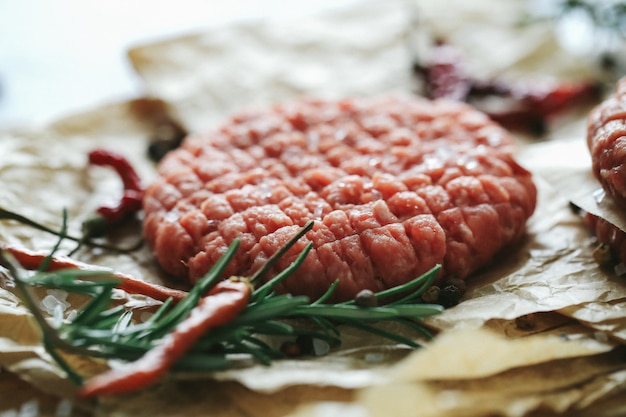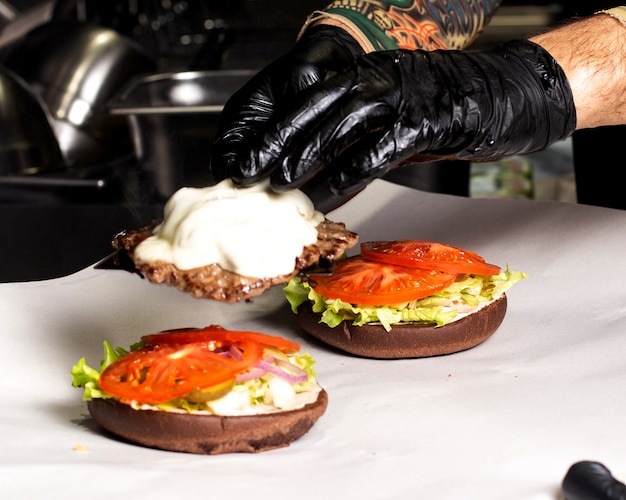Let’s be honest, we all have those nights when a juicy, flavourful burger is calling our name, but the last thing we want to do is spend hours in the kitchen. That’s where frozen burgers come in – a convenient and tasty solution to our burger cravings. But let's face it, cooking a frozen burger isn't always a straightforward affair. We've all experienced those dry, rubbery patties that leave us feeling disappointed. Fear not, my fellow burger enthusiasts! I'm here to share my hard-earned wisdom, gleaned from years of burger experimentation, to ensure you always end up with a delicious, satisfying burger, every single time.
Part 1: Understanding the Frozen Burger – A Time Capsule of Flavor

Before we get into the nitty-gritty of cooking, let's delve into the world of frozen burgers. These handy patties are essentially flavour time capsules – frozen to preserve their freshness. But this freezing process can impact their texture and moisture, which is where our culinary detective skills come in. We need to understand these frozen burgers and treat them with care to unlock their full potential.
1.1 Thawing: Unlocking the Flavor
The key to a juicy burger starts with thawing. Just chucking a frozen patty onto the grill isn’t going to cut it. It'll likely lead to a dry, overcooked mess. We need a gentle thawing process, allowing the burger to reach a safe temperature for cooking without becoming soggy.
1.2 Thawing Methods: Choosing the Right Approach
Let's explore the various thawing methods and pick the one that suits your needs.
- The Fridge Method: The classic slow-and-steady approach, ideal for those who can plan ahead. Pop your burgers into the fridge for 12-24 hours. This gentle method allows for even thawing and prevents the burger from becoming soggy. It's the ultimate "set it and forget it" method.
- The Cold Water Method: For those impulsive burger cravings, this method comes to the rescue. Submerge your burgers in a bowl of cold water. Change the water every 30 minutes to keep it cold, and your burgers should be thawed in about an hour. Be warned, this method works best for thinner burgers, as thick patties might take a bit longer.
- The Microwave Method: This one is a bit of a wildcard, and it’s not recommended for all frozen burgers. Always check the packaging to see if your burgers are microwave-safe. If they are, follow the instructions carefully. Just be aware that microwaving can sometimes lead to uneven cooking, resulting in a burger with a slightly rubbery texture. This method is best used for those desperate times when you need a quick fix.
Part 2: Choosing Your Culinary Weapon – The Right Cookware

With your burgers thawed, it's time to choose your culinary weapon of choice. Each cooking method has its own strengths and quirks. Let's explore the options and see which one suits your burger preferences and kitchen setup.
2.1 The Grill: Embrace the Smoky, Charred Flavor
The grill is the classic choice for a reason. It imparts that coveted smoky, chargrilled flavour we crave, and those beautiful grill marks are a welcome bonus. But remember, the grill can be a bit unforgiving, so keep a close eye on your burgers to prevent them from drying out.
2.2 The Skillet: Crisp Edges and Consistent Results
For a reliable and consistent cooking experience, a skillet is your go-to. It offers even heat distribution, creating a crispy, golden-brown crust on your burgers. It's also perfect for searing, which helps lock in those delicious juices.
2.3 The Oven: A No-Fuss Option
Let's face it, sometimes the kitchen feels like a battlefield, and you just want a quick and easy solution. The oven can be a lifesaver, especially if you're cooking multiple burgers or need to whip up a meal in a hurry. You can even bake your burgers alongside fries or other sides for a convenient one-pan meal. Just remember to preheat your oven to a moderate temperature, and keep a watchful eye on those burgers to ensure they don’t become overcooked.
Part 3: Mastering the Art of burger cooking – Technique is Key

Now that you've chosen your weapon of choice, let’s dive into the actual cooking process. It's time to master those techniques that will transform your frozen burgers from ordinary to extraordinary.
3.1 Preparing the Surface – Setting the Stage for Success
Before you start cooking, prepare your battleground. If you're using a grill, preheat it to medium heat. For a skillet, heat it over medium heat and add a tablespoon of oil or butter to prevent sticking. For the oven, preheat it to around 350°F (175°C). This ensures that your burgers cook evenly and develop a lovely crust.
3.2 cooking time: Finding the Sweet Spot
Okay, this is where it gets tricky – cooking time is a balancing act! It varies based on the size and thickness of your burgers, your chosen cooking method, and your preferred level of doneness. But here's a general guide:
- Rare: 2-3 minutes per side (internal temperature of 125°F/52°C) – This is for the adventurous souls who enjoy a cool centre.
- Medium-Rare: 3-4 minutes per side (internal temperature of 130°F/54°C) – A popular choice, offering a balance of pinkness and tenderness.
- Medium: 4-5 minutes per side (internal temperature of 140°F/60°C) – The classic choice, with a slight hint of pink in the centre.
- Medium-Well: 5-6 minutes per side (internal temperature of 150°F/66°C) – A safer option, with a slightly browned centre.
- Well-Done: 6-7 minutes per side (internal temperature of 160°F/71°C) – For those who prefer their burgers well-cooked, with no hint of pink.
3.3 Flipping: The Art of Timing
Resist the urge to constantly flip and poke your burgers. Patience is key! Let those patties sear for a good 3-4 minutes on each side before flipping. This allows a nice crust to form, locking in the juices and giving your burger that satisfying texture. You'll know it's ready to flip when it releases easily from the grill or skillet.
3.4 Temperature Control: The Thermometer’s Role
Don't rely solely on your eye! Invest in a meat thermometer to ensure your burgers are cooked to your desired level of doneness. It's the best way to avoid any potential food safety issues.
3.5 Resting: Let the Juices Redistribute
Just like a marathon runner needs a cool-down, your burger needs a rest after cooking. Take it off the heat and let it sit for 5-10 minutes before slicing and serving. This allows the juices to redistribute throughout the burger, resulting in a more tender, juicy, and flavorful bite.
Part 4: Elevating Your Burger Game – Tips for a Juicy, Delicious Patty
Now that you have the basics under your belt, let's explore those little tricks and tips that can take your frozen burger game to a whole new level.
4.1 Don't Overwork the Meat
Avoid overworking your burger when shaping it. Too much handling can make the meat tough and dense. Gently form it into a patty and leave it be. Let the heat do its magic, creating a juicy and tender burger.
4.2 Add Some Fat for Juiciness
Frozen burgers can sometimes be a bit lean. Adding a little fat can help keep them moist and flavorful. Try adding a small amount of butter, bacon grease, or a tablespoon of oil to the pan before cooking. This little trick makes a big difference.
4.3 Resist the Urge to Press Down
This is a common mistake. Pressing down on the burger while it's cooking forces out those precious juices, leaving you with a dry and disappointing burger. Let it cook undisturbed and resist the temptation to flatten it. Trust me, you'll be rewarded with a juicier, more satisfying burger.
4.4 Don't Forget the Toppings – A Celebration of Flavor
The right toppings can transform a good burger into an extraordinary one. Don't be afraid to get creative and experiment with your toppings. Classic choices like cheese, onions, lettuce, tomato, pickles, and bacon are always crowd-pleasers. But you can also get adventurous with additions like a fried egg, avocado slices, or even a dollop of homemade salsa. The possibilities are endless!
Part 5: Expanding Your Horizons – Variations and Beyond
Okay, so we've covered the basics of cooking frozen burgers, but what if you want to take your burger game to the next level? Let's explore some variations and ideas that will inspire your inner culinary artist.
5.1 Spice It Up! – Embracing flavor profiles
Why stick with plain old burgers when you can add a little spice? Experiment with different flavor profiles to satisfy your taste buds. Try adding a teaspoon of chili powder, paprika, or even some cayenne pepper to your burger mix for a subtle kick. You can also experiment with different spice blends or create your own signature flavour combination.
5.2 Embrace the Veggie Burger – A Delicious Alternative
Don't feel limited to beef! There are tons of delicious veggie burger options out there, made with ingredients like black beans, lentils, mushrooms, or even quinoa. These patties are packed with protein and fibre, and they can be surprisingly satisfying. You can cook them using the same methods as beef burgers, and they pair perfectly with your favourite toppings.
5.3 Go Beyond the Bun – Reimagining the Burger
Think outside the bun! Instead of the classic burger bun, try serving your burgers on toasted bread, a bed of greens, or even in a lettuce wrap. This can add a refreshing twist and offer some creative options, especially if you're looking for a lighter meal.
5.4 Create a burger bar – A Celebration of Choice
Throw a burger party and set up a burger bar with a variety of toppings, buns, and sauces. Let your guests customize their own creations. It's a fun way to get creative and share the love for burgers. You can even have a competition for the most creative burger concoction!
Part 6: FAQs: Addressing Those Common Burger Concerns
Let's tackle those frequently asked questions you might have about frozen burgers. We've all been there!
6.1 How Long Can I Keep Frozen Burgers in the Freezer?
Frozen burgers can typically last in the freezer for 3-4 months. Just be sure to store them in airtight packaging to prevent freezer burn.
6.2 Can I Refreeze a Frozen Burger?
It's not recommended. Once a frozen burger has been thawed, it's best to cook it immediately. Refreezing can affect the quality and texture of the meat.
6.3 How Do I Know if My Burger is Cooked Properly?
The best way to check if your burger is cooked properly is to use a meat thermometer. The internal temperature should reach at least 160°F (71°C) for well-done. But remember, personal preference plays a role, so cook it to your liking!
6.4 What Happens if I Overcook My Burger?
Overcooked burgers can be dry and tough. They may also lose their juicy flavour. That's why it's important to cook them to the desired level of doneness and not overcook them.
6.5 Can I Freeze a Cooked Burger?
Yes, you can freeze cooked burgers, but it's best to freeze them without toppings. They can last in the freezer for up to 2 months. Just be sure to store them in airtight containers or freezer-safe bags. To reheat, you can microwave them or bake them in the oven.
Part 7: Beyond the Burger – Tips for Perfecting Other Frozen Foods
So, you've mastered the art of the frozen burger, but what about other frozen delights? Fear not, my culinary comrades! Here are some tips that can help you unlock the potential of other frozen food treasures.
7.1 Frozen Vegetables: A Time-Saver with Flavor
Frozen vegetables are a lifesaver for quick and easy meals. They're often just as nutritious as fresh vegetables, and they can add flavour and texture to your dishes. You can steam them, sauté them, or even roast them for a delicious side dish. Just be sure to use the correct cooking method based on the type of vegetable.
7.2 Frozen Fruits: A Sweet and Convenient Treat
Frozen fruits are perfect for smoothies, ice cream, or even baked goods. They can add a burst of sweetness and flavour without adding extra sugar. You can also use them to make homemade popsicles or sorbet.
7.3 Frozen Pizza: The Ultimate comfort food
Let's be real, frozen pizza is a guilty pleasure for many. But you can actually make it taste even better! Try adding some extra toppings, like fresh herbs, vegetables, or even a drizzle of olive oil. You can also bake it in a preheated oven for a crispy crust.
Part 8: The Final Verdict: Frozen Food Doesn’t Have to Be Boring
Well, there you have it, a comprehensive guide to cooking frozen burgers and other frozen foods to perfection. It's all about a little bit of knowledge, a dash of patience, and a whole lot of culinary creativity. Don't be afraid to experiment, try new things, and embrace the delicious possibilities of frozen food. You might just be surprised at what you can create!
Everyone is watching

How to Cook Frozen Lobster Tails Perfectly: A Step-by-Step Guide
RecipesLobster. Just the word conjures up images of lavish meals, special occasions, and a taste of luxury. But let's...

Pigs in a Blanket Cooking Time: How Long to Bake for Perfect Results
RecipesAh, pigs in a blanket. Just the name conjures up images of those delightful little parcels of crispy pastry en...

Pork Fillet Cooking Time: How Long to Cook It Perfectly
RecipesPork fillet, or tenderloin as it's sometimes called, is a real favourite in our house. It's so versatile, and...

The Ultimate Guide to Tender, Juicy Pulled Pork
RecipesRight, let's talk pulled pork. It's one of those dishes that just screams "comfort food," doesn't it? I mean...

The Ultimate Guide to Cooking Sweet Potatoes: From Roasting to Mashing
RecipesSweet potatoes. Just the name conjures up images of warm, comforting dishes, bursts of vibrant color, and a to...
